The Waxing Moon Meets Venus in Evening While Morning Planets Dance!
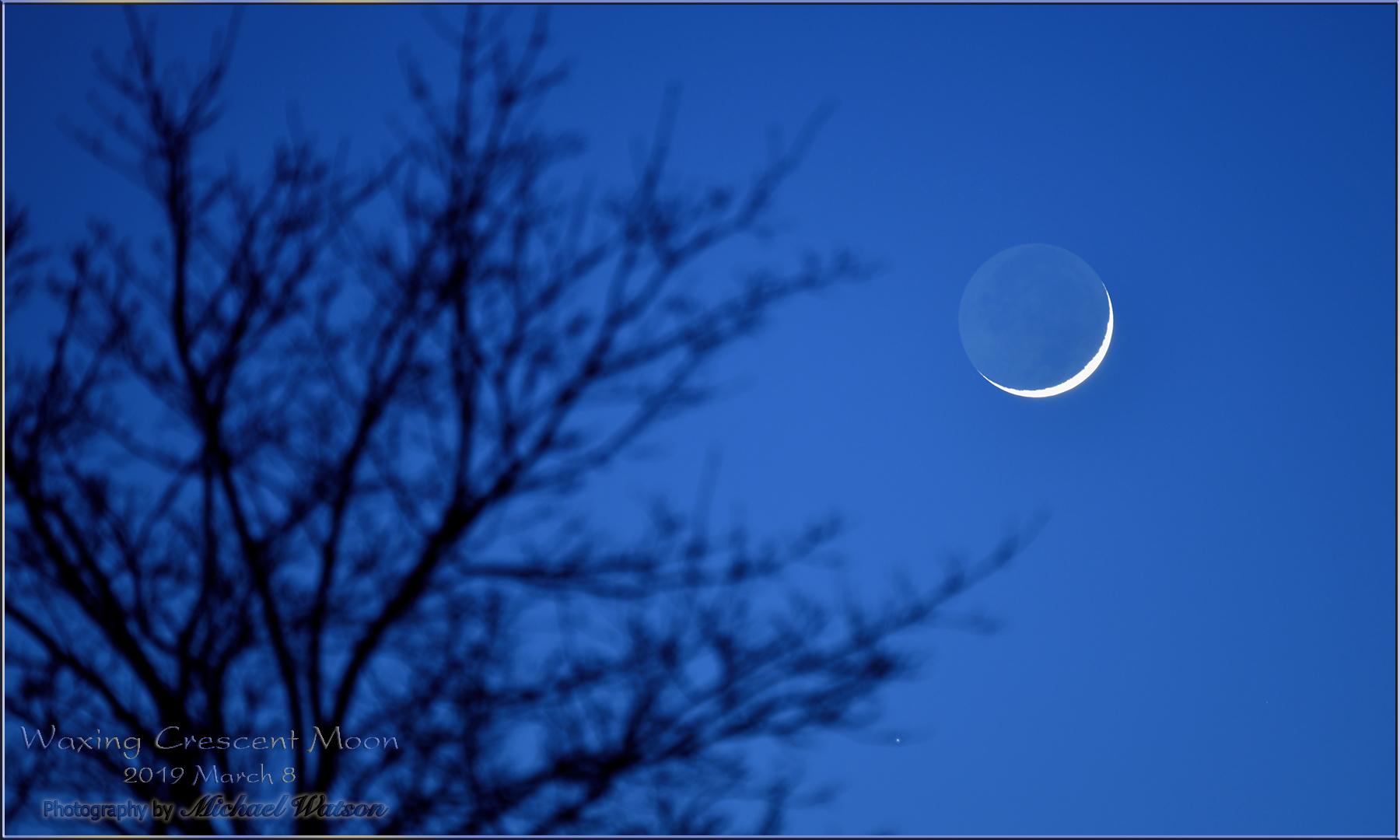
This image by Michael Watson of Toronto nicely captured earthshine on the waxing crescent moon after sunset on March 8, 2019. Michael’s terrific galleries of moon images are hosted on his Flickr page.
Hello, May Stargazers!
Here are your Astronomy Skylights for the week of May 21st, 2023 by Chris Vaughan. Feel free to pass this along to your friends and send me your comments, questions, and suggested topics. I repost these emails with photos at http://astrogeo.ca/skylights/ where the old editions are archived. You can also follow me on Twitter as @astrogeoguy! Unless otherwise noted, all times are expressed in Eastern Time. To subscribe to these emails please click this MailChimp link.
If you’d like me to bring my Digital Starlab portable inflatable planetarium to your school or other daytime or evening event, or deliver a session online, contact me through AstroGeo.ca, and we’ll tour the Universe, or the Earth’s interior, together! My terrific book with John A. Read entitled 110 Things to See With a Telescope is a guide to viewing the deep sky objects in the Messier List – for both beginners and seasoned astronomers. DM me to order a signed copy!
The pretty crescent moon will visit Venus, Mars, and the Beehive Cluster in the evening hours as it waxes in phase. I share some easy-to-see lunar sights for each night. Meanwhile, speedy Mercury joins the bright planets Saturn, Jupiter before sunrise. Read on for your Skylights!
The Moon
The moon will grace the evening sky worldwide this week as it waxes from a crescent through its first quarter phase. During this part of the lunar month, our natural night-light rises during the afternoon hours and then draws our attention as the sky darkens after sunset. It will also be setting around the middle of the night – allowing those of us who want to view faint nebulae and galaxies to grab a nap and then turn our telescopes skyward during the post-midnight hours, when the sky is darkest.
Tonight (Sunday), the pretty crescent moon will shine to the lower right (or celestial west) of bright Venus. Watch for earthshine to brighten the unlit portion of the moon. Although the moon will be shining in Taurus (the Bull), the stars of Gemini (the Twins) and Auriga (the Charioteer) will be the ones you’ll see twinkling above the moon just before it sets at around 11 pm local time.
On Monday evening, the crescent moon will pose for a photo opportunity while it shines to the lower right (or celestial northwest of) very bright Venus. Reddish Mars and Pollux and Castor, the brightest stars of Gemini, will sparkle above the moon. The Moon’s easterly orbital motion will swing it somewhat closer to Venus before the grouping sets around 11:30 pm local time. Skywatchers viewing the scene from more westerly time zones will see the moon and Venus even closer together.
On Tuesday evening, after 24 hours of easterly motion, the slightly fuller moon will be situated between Venus and much fainter Mars. Pollux will shine two finger widths above (or two degrees to the celestial north-northeast of) the Moon. As the hours pass, the Moon will noticeably slide a little closer to Mars and farther from Venus. Viewers in westerly time zones will see the Moon making a line with Pollux and Castor.
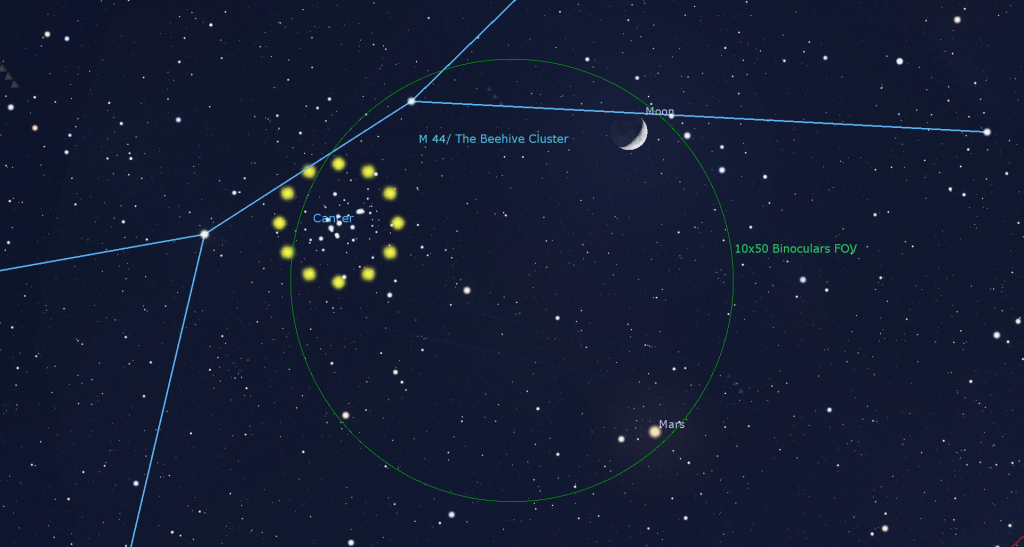
The waxing Moon’s trip past the bright evening planets will continue on Wednesday evening. That night, the five-day-old Moon’s crescent will shine in Cancer (the Crab), several finger widths above (or four degrees to the celestial northeast of) Mars. The large open star cluster known as the Beehive, Messier 44, and NGC 2632 will form an equilateral triangle to the left of the Moon and Mars. All three objects will share the view in binoculars, but to see the “bees,” which cover an area more than twice the Moon’s diameter, hide the bright Moon just beyond the right edge of your field of view.
The moon will continue to wax fuller and rise later each night. It will spend Thursday to Saturday traversing the stars of Leo (the Lion), officially completing the first quarter of its orbit around Earth at 11:22 am EDT, 8:22 am PDT, or 15:22 Greenwich Mean Time on Saturday. That evening, the 90 degree angle formed by the Earth, sun, and moon will cause us to see our natural satellite half-illuminated – on its eastern side until it sets around midnight. The moon will end the week next Sunday night by starting a trip through Virgo (the Maiden). By then it will show a slightly gibbous, 64%-illuminated phase.
The evenings surrounding the first quarter phase are the best ones for using binoculars and backyard telescopes to view the lunar terrain when it is dramatically lit by low-angled sunlight. The rays of sunshine that strike the moon near the curved, pole-to-pole lunar terminator cast shadows from every bump, hill, ridge, mountain, and crater rim. As the moon’s angle from the sun increases each night, that terminator slides west across the moon, casting new strips of the lunar terrain into stark relief. The observation that the terminator straightens out as the moon waxes to first quarter is proof that the moon is a spheroid.
Let’s review a few of the best sights to see on a magnified moon. Tonight (Sunday), very little of the moon will be illuminated, but you can try exploring the parts of the moon that are dimly lit by earthshine.
On Monday evening, the dark oval of Mare Crisium will be fully visible within the upper section of the moon’s fetching crescent. On Tuesday evening, the crescent will widen to include dark Mare Fecunditatis below Mare Crisium. Its edges are less distinct. Even with your unaided eyes, a big crater named Langrenus can be seen on the right-hand (lunar eastern) edge of Fecunditatis. Its location near the moon’s horizon makes the round crater appear oval from Earth.
On Wednesday night, the mountain-ringed circle of Mare Nectaris will be nearly fully illuminated. It’s located just to the lower right (lunar southwest) of Mare Fecunditatis. Look above Fecunditatis, where the eastern half of the Mare Tranquillitatis will be visible. A bright spray of lunar ejecta shining between Tranquility and Mare Crisium is the asymmetrical ray system around the small crater named Proclus. Watch for several large, deep craters with their floors still in shadow in the lower portion of the crescent.
On Thursday, the curved trio of large craters Theophillus, Cyrillus, and Catharina will be prominent to the left of Nectaris. You can tell what order they were formed in by observing how sharp and fresh Theophillus’ rim appears, and by the way its rim has overprinted neighboring Cyrillus.
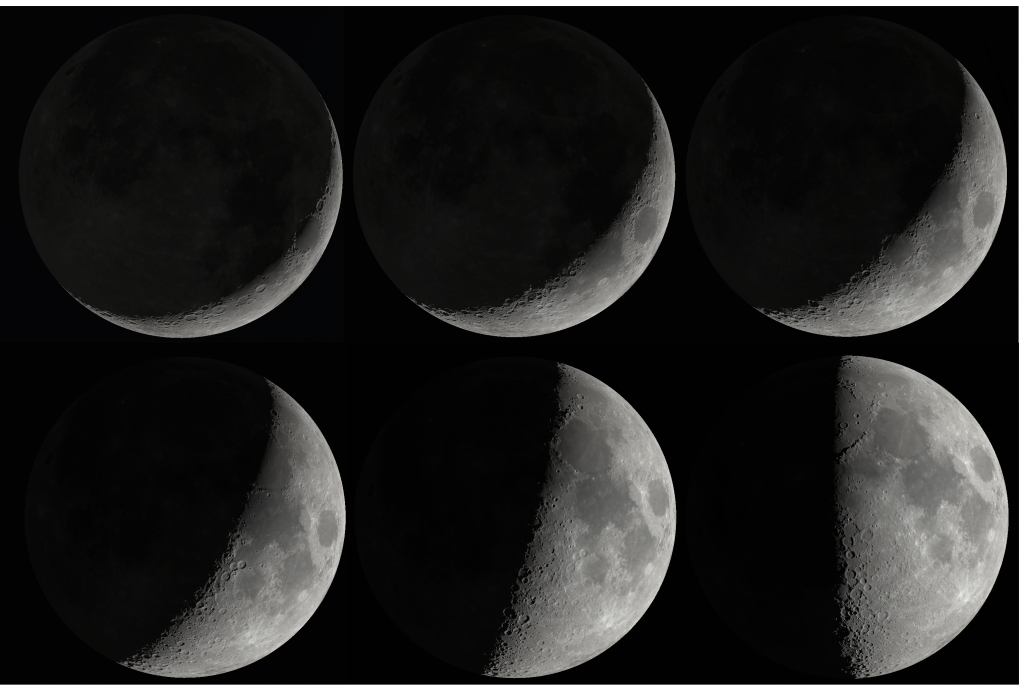
On Friday night, the terminator will have shifted far enough west to illuminate all of the large, dark oval of Mare Serenitatis. It connects to Mare Tranquillitatis’ upper left (lunar northwest) edge. Serenitatis is ringed by mountains. Notice that Mare Tranquillitatis in darker and bluer in tone than Mare Serenitatis, due to titanium enrichment in its basalts.
Several large craters with their floors still in darkness will straddle the terminator on Friday, especially the stretch south of the moon’s equator. The largest one, Albategnius sits right on the equator. The medium-sized crater Stöffler is located much farther south, with the somewhat smaller craters Aliacensis and Licetus bracketing it.
On Saturday night, Friday’s dark-floored craters will be fully illuminated and easy to see. Another one named Maginus in the southern part of the moon will take its turn as a dark hollow. Look for an up-down trio of connected craters Ptolemaeus / Alphonsus / Arzachel. The northernmost crater Ptolemaeus (154 km wide) has been battered by later impacts that confirm its older age. The flat, almost featureless floor has been filled by lava flows, submerging its central peak and elevating its floor. Alphonsus (119 km wide) is older yet and partially filled, allowing its central peak to remain visible. Alphonsus contains a triangle of dark spots that are most prominent when the moon is full – ash deposits from long-ago volcanic venting. Relatively young Arzachel (96 km wide) has an unaltered floor and a terraced rim. A large number of north-south scratches, or lineations, surround those craters – carved by ejecta during the powerful Imbrium Basin impact event. Just south of that trio are another up-down set named Purbach / Regiomontanus / Walther.
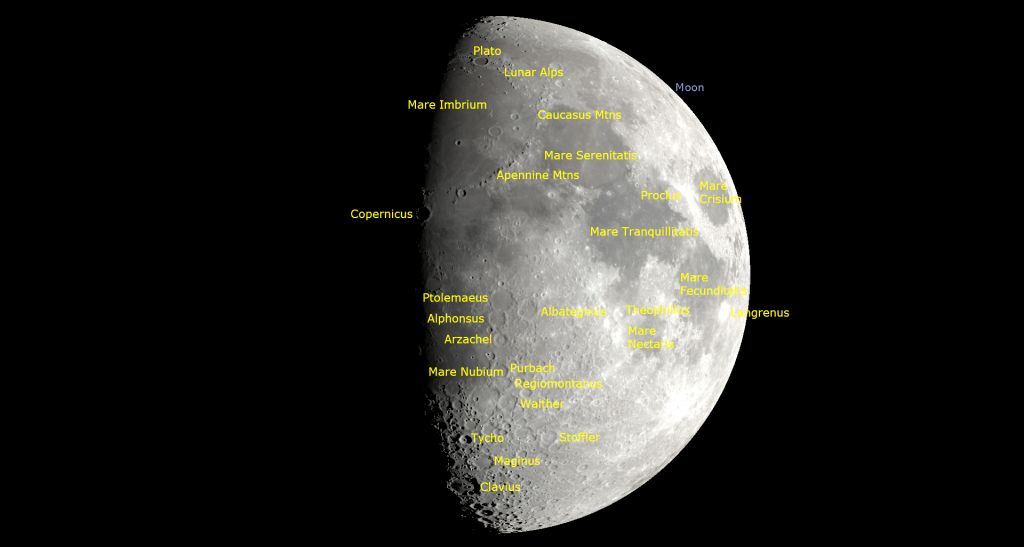
The northern section of Saturday’s moon will be dominated by the eastern semi-circle of the great Imbrium Basin. It is ringed by three spectacular and tall mountain ranges that were pushed up during its formation. The northern arc is the Lunar Alps. The southern arc is the Apennine Mountains. The less continuous Caucasus Mountain range that curves between them is breached where Imbrium meets Serenitatis. Observers in parts of Asia and Oceana on Saturday will be able to see the Lunar X and Lunar V features for several hours centered on 6:30 GMT.
On Sunday night, more of Mare Imbrium will be visible. Look for the dark, round crater named Plato along its northern rim. The big crater Copernicus will be straddling the terminator. Most of dark Mare Nubium to the south of Copernicus will be in sunlight. Sunday’s terminator across Mare Nubium will fall just to the left (or lunar west) of Rupes Recta, also known as the Lunar Straight Wall. The rupes, Latin for “cliff”, is a north-south aligned fault scarp that extends for 110 km across the southeastern part of Mare Nubium. The wall, which is very easy to see in good binoculars and backyard telescopes, is located above the very bright, central-peaked crater Tycho.
Look near the moon’s southern pole on Sunday for one of my favorite craters, large Clavius. This one was featured in the film 2001: A Space Odyssey. Binoculars or a backyard telescope will reveal a curved chain of craters, each descending in diameter, inside Clavius.
There’s a very nice moon map here.
The Planets
Brilliant Venus will continue to dominate the western sky during evening this month. It will first appear about one-third of the way up the western sky at sunset. Then it will descend and set around midnight in your local time zone.

Once the sky darkens more, look for the bright stars of the Arch of Spring asterism above and to either side of Venus. From left to right (or celestial southeast to northwest of Venus) they are white Procyon (Alpha Canis Minoris) to Venus’ left, white Castor and golden Pollux (Alpha and Beta Geminorum respectively) above Venus, and yellowish Capella (Alpha Aurigae), with the fainter white star Menkalinan to its upper left, sparkling off to Venus’ right. Each night, those stars will drop a little lower and sunward, causing Venus to shift “higher” compared to them.
The rather underwhelming, reddish dot of Mars will continue to accompany Venus in the west this week. It will be positioned about 1.5 fist diameters to Venus’ upper left. Their separation will decrease a little each night. Since Mars is now fainter than the stars Pollux and Castor, it won’t become visible until the sky is relatively dark. Like Venus, Mars will look best in a telescope while it is highest – right at dusk – but its ruddy disk will look tiny under any magnification. Mars will set at about 1 am local time.
The only other solar system object worthy of attention in the evening sky this week will be the minor planet designated (1) Ceres, the largest object in the main asteroid belt. The magnitude 8.1 object, which is visible in big binoculars and backyard telescopes, will be creeping southward near the borders between the constellations of Virgo (the Maiden), Coma Berenices (Berenice’s Hair) and Leo (the Lion). Search for its speck about two finger widths to the left (or 2.5 degrees to the celestial east) of the very bright star Denebola.
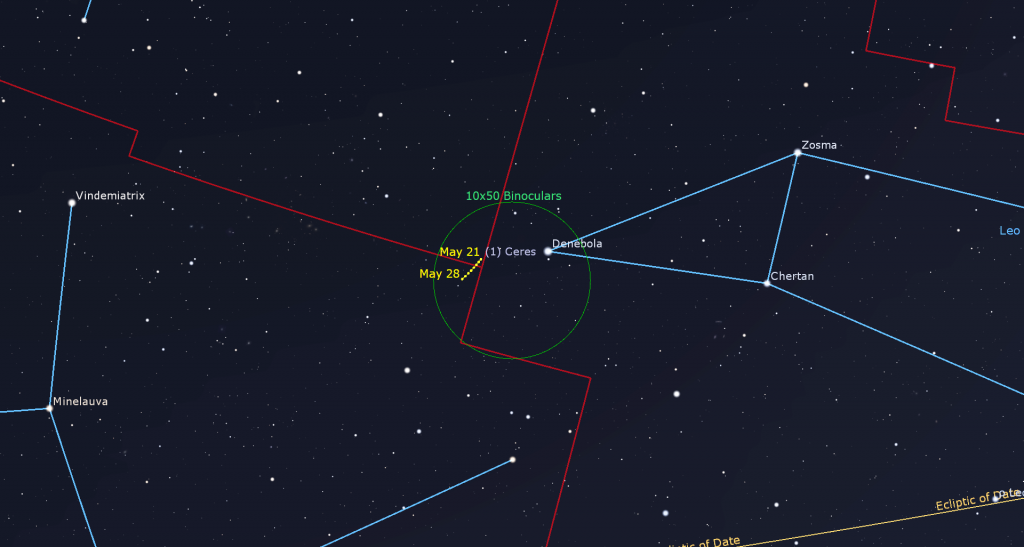
The gas giant planets are putting on a show in the eastern pre-dawn sky! The bright yellowish dot of Saturn will clear the trees in the southeast by about 3:45 am local time. The fainter stars of Aquarius (the Water-Bearer) will surround it as it climbs a little higher and shifts to the right (celestial westward) – until the brightening sky steals it away around 5 am.
The bright stars of the Summer Triangle asterism will sparkle above Saturn all year. The part of the sky will rise about half an hour earlier each week, so you’ll see Saturn rising around midnight at the end of June, and then it’ll be available for your evening telescope viewing pleasure all summer and into mid-winter! The planet Neptune is located in western Pisces (the fishes), about two fist width to Saturn’s lower left. But it’s too soon to chase down that faint, distant blue planet.
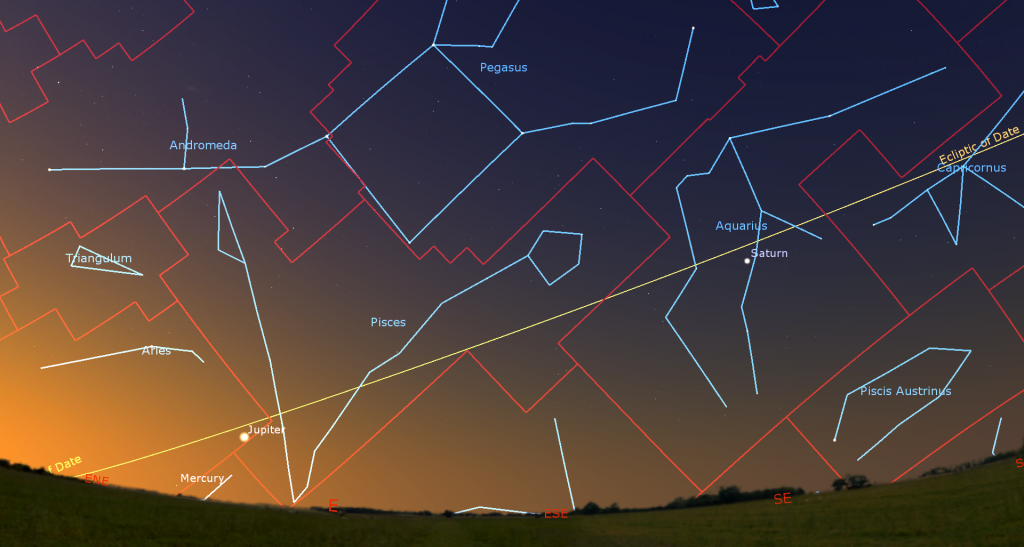
The giant planet Jupiter will rise about two hours after Saturn – at about 4:30 am local time. It will appear about 16 times brighter than Saturn, so you’ll be able to see it gleaming just above the eastern rooftops until almost sunrise. The tilt of the morning ecliptic will keep the big planet relatively low in the sky for now. Observers at mid-northern latitudes will start seeing Jupiter more easily in a few weeks time.
From time to time, observers with good telescopes can watch the small, round, black shadows of the Galilean moons travel across Jupiter’s disk. On Thursday morning, May 25, observers in the Pacific Ocean region can see a rare treat when two shadows cross the southern hemisphere of Jupiter, together with the Great Red Spot! West of Hawaii the two shadows will already be mid-planet when Jupiter rises. At 3:36 am Tahiti Time (or 15:36 GMT) Europa’s shadow will move off Jupiter, leaving the red spot and Io’s shadow to complete their crossings by 3:57 am THAT (or 15:57 GMT). By then the sky will be brightening.

On Sunday morning, May 28, lucky residents in the central Africa region can see the shadows of Io and Europa cross the southern hemisphere of Jupiter. At westerly longitudes the two shadows will already be crossing when Jupiter rises. At 5:55 am West Africa Time (or 04:55 GMT) the shadows will move off Jupiter together. By then the sky will be brightening.
If you live at a southerly latitude, Jupiter is already an easy target – and you’ll be able to see the elusive planet Mercury as it swings farther from the morning sun. This week, Mercury will be located less than a fist’s width to Jupiter’s lower left (or 8° to the celestial east) – but you’ll need a cloud-free, unobstructed eastern horizon to see it – unless you live near the tropics. Unfortunately, this will be a poor apparition of Mercury for viewers at mid-northern latitudes.
Perusing the Ploughman
The mild temperature, moonless evening skies this week offer a fine opportunity to explore the realm of Boötes (“Bow-OH-tees”), the Herdsman or Ploughman.
Public Astro-Themed Events
Every Monday evening, York University’s Allan I. Carswell Observatory runs an online star party – broadcasting views from four telescopes/cameras, answering viewer questions, and taking requests! Details are here. They host in-person viewing on the first clear Wednesday night each month. Other Wednesdays they stream views online via the observatory YouTube channel. Details are here.
Taking advantage of the crescent moon in the sky this week, the RASC Toronto Centre astronomers will hold their monthly City Sky Star Party in Bayview Village Park (steps from the Bayview subway station), starting after dusk on the first clear weeknight this week (Mon, Tue, or Thu only). Check here for details, and check the banner on their website home page or Facebook page for the GO or NO-GO decision around 5 pm each day.
Eastern GTA sky watchers are invited to join the RASC Toronto Centre and Durham Skies for solar observing and stargazing at the edge of Lake Ontario in Millennium Square in Pickering on Friday evening, May 26, from 6 pm to 11 pm. Details are here. Before heading out, check the RASCTC home page for a Go/No-Go call – in case it’s too cloudy to observe.
My free, family-friendly Insider’s Guide to the Galaxy webcast with RASC National returns on Tuesday, May 23 at 3:30 pm EST. We’ll talk about how to plan a summer star party and what are the dos and don’ts for attendees. Then we’ll highlight our next batch of spring RASC Finest NGC objects. You can find more details and the schedule of future sessions here.
Keep looking up, and enjoy the sky when you do. I love questions and requests. Send me some!